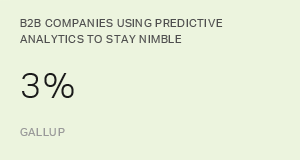Story Highlights
- B2B sales processes and customer engagement are suffering
- Reevaluate existing sales processes to attract enterprise clients
- Capture more revenue during disruption with three key strategies
Even before the COVID-19 pandemic created a universal "reset" of the business landscape, many leaders missed opportunities to grow their business-to-business sales.
B2B sales processes -- and customer engagement -- have especially suffered.
In turn, revenue has been dismal: Gallup analytics shows that there is always a minimum of two times your customer billings just left sitting on the table due to not fully engaging your customers.
To retain and attract enterprise clients in an even more competitive and uncertain market, B2B sales teams need to reevaluate their existing sales processes -- starting with competitive bid proposals.
An organization's ability to generate a "winning" proposal is a key indicator of its ability to meet sales expectations and increase revenue.
Most proposals are written as technical documents for procurement teams, meant to merely check the box. Enterprise sales leaders often miss a big opportunity to craft a proposal for what it can be: a business value proposition.
To remedy this problem, leaders need to ramp up their customer feedback measures to better understand how they can improve their offerings and approach their prospects. Less than 20% of companies perform a win-loss review on bids -- which means most organizations miss a key opportunity to collect revenue-driving customer feedback.
Customers' perceptions of a company's sales processes can provide invaluable insights that help leaders coach sales teams to recognize and resolve problems right from the start.
Well-informed sales teams can perfect their techniques, avoid repeating mistakes and deliver engaging experiences for customers.
Gallup has identified three strategies to help leaders capture more revenue -- even during disruption.
1. Learn from losses.
Sales teams that lack customer feedback often blame lost bids on price. It's true that price will always be a big component of a successful bid, but buyers today are often more interested in the value they will receive. Account managers and sales leaders might hear the client or prospect say they want to "reduce costs" and equate that to "low-cost." But often, clients are seeking cost-to-value and cost optimization over the lowest-priced bid.
To retain and attract enterprise clients in an even more competitive and uncertain market, B2B sales teams need to reevaluate their existing sales processes.
Gallup recently conducted a loss analysis for a Fortune 500 company, which began with interviewing senior sales leaders of the lost account. When Gallup asked the sales leaders why they thought they lost, one leader responded, "I've been on this account for a long time, and our proposal was good. We gave them everything they asked for, but they were just looking for the lowest-priced option."
In contrast, when Gallup consultants asked the client the same question, they learned that the client felt differently. The client said, "Cost will always be a part of any proposal. But what we were looking for was value over cost. And while [the sales team] did check all the boxes, we asked for a Tesla and they brought a Nissan."
This gap in expectations -- the inconsistency between sales teams' perceptions and prospects' actual experiences -- is not unusual.
Gallup finds that systematically analyzing losses like this can yield eye-opening discoveries that can help leaders and sales teams learn from losses as they aim to maximize future opportunities.
2. Know what you are best at.
Before any solution can be proposed to a client or prospect, sales leaders must first define what they are best at. In other words, they must define key win themes. Key win themes are the strengths or competitive advantage that a company brings to the table in the proposal.
As basic as it may seem, many leaders and their sales teams struggle to define what excellence in their product offerings looks like. And because it is rare that any organization can claim to be the best at everything, leaders and their teams end up losing when they try to compete on it all. After all, in competitive markets, most products and services are commoditized in some shape or fashion.
"Cost will always be a part of any proposal. But what we were looking for was value over cost. And while [the sales team] did check all the boxes, we asked for a Tesla and they brought a Nissan."
The ability to define the organization's unique competitive advantage with customers and then apply those capabilities to the solution being provided is the key to discovering best practices that can be replicated in the future. While a sales leader's key win themes may not work in every situation, in the very least they serve as a foundation for an aligned culture of customer centricity. This gives leaders and their sales teams something to rally around as they aim to win every time.
3. Perform health checks with existing clients.
Too often, sales teams approaching competitive bids have a false sense of security about clients' desire to renew.
The truth is that clients hold incumbents to higher standards -- they expect them to be intimately familiar with their business.
The best leaders give their sales teams a major edge by continuously gauging impact on the customer's business -- long before the bidding process starts again. They constantly look for ways to improve the relationship and serve as a trusted adviser rather than a transactional vendor.
When leaders provide tailored services and continually track impact on clients' business goals, they become a trusted partner and demonstrate that they value their clients. This strengthens customer engagement and cultivates deep, meaningful, mutually beneficial client relationships.
Exceptional B2B leaders also collect key stakeholder input through in-depth interviews, which allow sales teams to hear in the client's own words how their work is making a difference and where adjustments could maximize client outcomes.
In the end, many B2B companies collect data with customer surveys. But do they really know where they stand with their customers?
Such surveys provide essential insights on what is occurring with customers but do little to offer the why and the how something is occurring.
Beyond enhancing their proposals by taking into account learning from losses and amplifying what they are best at, sales teams must move toward including the voice of the customer throughout their relationship in a number of ways.
Sales leaders and their teams must systematically learn from losses, perform regular health checks with customers that include both analytics and scheduled stakeholder input, and position what they do best as a company to define how they will engage with customers right from the start.
Doing these things will help position leaders and their teams to win, even in this challenging market.
Learn about more of Gallup's practical solutions for B2B leaders:
- Uncover Gallup's strategies for overcoming B2B challenges.
- Download Analytics and Advice for B2B Leaders to learn how to generate revenue by accelerating customers' businesses.
- Watch our webinar "The Silver Lining of Customer Problems" to learn how you can turn customer problems into growth opportunities.






